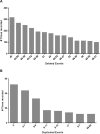The TREAT-NMD DMD Global Database: analysis of more than 7,000 Duchenne muscular dystrophy mutations
- PMID: 25604253
- PMCID: PMC4405042
- DOI: 10.1002/humu.22758
The TREAT-NMD DMD Global Database: analysis of more than 7,000 Duchenne muscular dystrophy mutations
Abstract
Analyzing the type and frequency of patient-specific mutations that give rise to Duchenne muscular dystrophy (DMD) is an invaluable tool for diagnostics, basic scientific research, trial planning, and improved clinical care. Locus-specific databases allow for the collection, organization, storage, and analysis of genetic variants of disease. Here, we describe the development and analysis of the TREAT-NMD DMD Global database (http://umd.be/TREAT_DMD/). We analyzed genetic data for 7,149 DMD mutations held within the database. A total of 5,682 large mutations were observed (80% of total mutations), of which 4,894 (86%) were deletions (1 exon or larger) and 784 (14%) were duplications (1 exon or larger). There were 1,445 small mutations (smaller than 1 exon, 20% of all mutations), of which 358 (25%) were small deletions and 132 (9%) small insertions and 199 (14%) affected the splice sites. Point mutations totalled 756 (52% of small mutations) with 726 (50%) nonsense mutations and 30 (2%) missense mutations. Finally, 22 (0.3%) mid-intronic mutations were observed. In addition, mutations were identified within the database that would potentially benefit from novel genetic therapies for DMD including stop codon read-through therapies (10% of total mutations) and exon skipping therapy (80% of deletions and 55% of total mutations).
Keywords: DMD; Duchenne muscular dystrophy; TREAT-NMD; rare disease registries.
© 2015 The Authors. **Human Mutation published by Wiley Periodicals, Inc.
Figures




References
-
- Aartsma-Rus A, Fokkema I, Verschuuren J, Ginjaar I, van Deutekom J, van Ommen GJ, den Dunnen JT. Theoretic applicability of antisense-mediated exon skipping for Duchenne muscular dystrophy mutations. Hum Mutat. 2009;30:293–299. - PubMed
-
- Aartsma-Rus A, Janson AA, Kaman WE, Bremmer-Bout M, den Dunnen JT, Baas F, van Ommen GJ, van Deutekom JC. Therapeutic antisense-induced exon skipping in cultured muscle cells from six different DMD patients. Hum Mol Genet. 2003;12:907–914. - PubMed
-
- Aartsma-Rus A, Van Deutekom JC, Fokkema IF, Van Ommen GJ, den Dunnen JT. Entries in the Leiden Duchenne muscular dystrophy mutation database: an overview of mutation types and paradoxical cases that confirm the reading-frame rule. Muscle Nerve. 2006;34:135–144. - PubMed
-
- Ahn AH, Kunkel LM. The structural and functional diversity of dystrophin. Nat Genet. 1993;3:283–291. - PubMed
Publication types
MeSH terms
Substances
Grants and funding
LinkOut - more resources
Full Text Sources
Other Literature Sources
Medical

